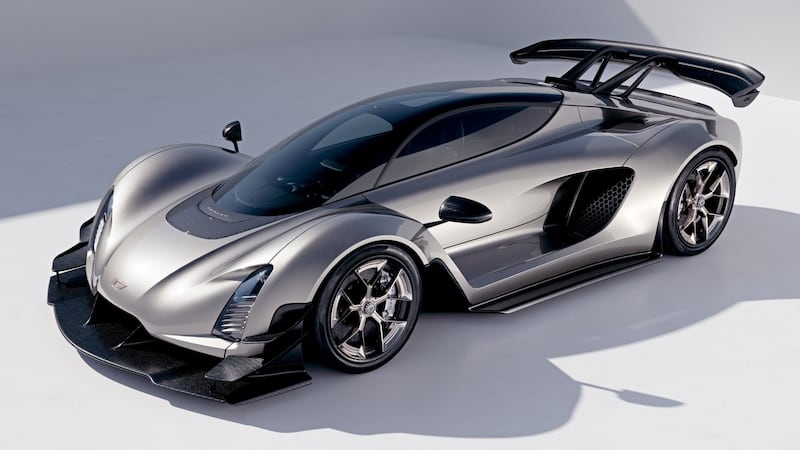The future of high-performance motoring is electric, right? I mean, it stands to reason: electric motors are cheaper by far to make than combustion engines, and they can provide huge power and torque for minimal effort, quite apart from their environmental benefits.
Imagine, if you will, having the sort of power and performance that can humble a Bugatti Chiron but with no prickling of your eco-conscience. It can be done, and Rimac has, apparently, just done it.
If you've not heard of Rimac, don't worry. You may not, but within the global car industry the likes of Porsche, Aston Martin, Kia, Hyundai, Cupra and Renault all have, and have not only heard of the Croatian-based electric-car maker but have been sufficiently impressed to sign investments and deals for Rimac to supply them with its technology.
Rimac claims a 0-97km/h time of just 1.85sec, and a top speed of 412km/h, assuming you own your own race track or have access to the runway at Shannon
Now, following years of prototypes and concept cars, Rimac is unleashing its first full production model, the Nevera. Named for a Mediterranean storm that brews up and lashes the coast of Croatia, each Nevera will cost €2 million (not including local taxes – enjoy your VRT inspection), and only 150 will be made.
If that sounds ambitious for a car-maker that few have heard of and which is based in a country not necessarily renowned for being an automotive hot spot (the "classic" Yugo hatchback was made in Serbia, alas…) then the Rimac Nevera arrives with impeccable credentials.
Chief among which is 2,000hp – well, 1,915hp, to be a little more precise – from four electric motors, one behind each wheel.
Unsurprisingly with that kind of power, performance is – and there’s no other way of saying it – electric. Rimac claims a 0-97km/h (60mph) time of just 1.85sec, and a top speed of 412km/h, assuming you own your own race track or have access to the runway at Shannon.
There’s a 120kWh battery, which gives the Nevera a WLTP one-charge range of 550km, and that can be recharged to 80 per cent full in just 19 minutes, from a sufficiently fast DC charger.
There’s a lot of high tech on board, too, not least steer-by-wire and brake-by-wire (there is no physical connection between the pedals and the wheel and the systems they operate), active aerodynamics which adjust on the fly between high downforce and low drag modes, and the “driver coach”.
This last is an interactive system that uses 12 ultrasonic sensors, 13 cameras, six radars and the very latest NVIDIA Pegasus operating system, plus built-in maps of major race tracks, and which can actually actively turn the steering, pump the brakes and adjust the aero to help you turn in a hot lap.
Dramatic bodywork? Tick. Aggressive aerodynamics? Tick. Oddball seating? Tick – the Czinger C21 is a two-seater, but you sit one behind the other, as in a fighter jet
“This is it. This is the car I had in mind when I embarked on the ‘impossible’ journey 10 years ago. All our hard work has resulted in the Nevera – our record-breaking hypercar. This car was born to outperform, and to raise the bar, redefining the norm for performance cars. And not only in performance, but as an all-around package,” says Mate Rimac, founder and chief executive of Rimac Automobili.
Hang on, though: maybe electric isn’t the only solution. Across the Atlantic, the Los Angeles-based company Czinger has revealed the production-ready version of its C21 hypercar. It arrives ticking many of the modern-hypercar boxes.
Dramatic bodywork? Tick. Aggressive aerodynamics? Tick. Oddball seating? Tick – the Czinger C21 is a two-seater, but you sit one behind the other, as in a fighter jet.
It even has an odd name – the C is silent, so you just pronounce it “Zinger”. Czinger even says that it has used artificial intelligence to help it design the C21.

But it’s not electric. Well, not entirely – two compact electric motors in the nose drive the front wheels and allow for some of the infinitely adjustable power deployment that the Rimac offers on all four of its wheels. The main source of motive power, though, is the specially designed 2.88-litre V8 petrol engine mounted behind the fighter-jet-style cockpit. Combined with the electric motors, this produces a fairly whopping 1,250hp, with an optional upgrade to 1,350hp.
That allows Czinger to claim similar performance to the Rimac, with 100km/h coming up from a standing start (the Rimac needs a 30cm rolling start) in 1.9sec, and a claimed 453km/h top speed, if you tick the box for the optional “low-drag aero” package.
Not very eco-friendly? Not so, claims Czinger. The company points out that the V8 engine has been designed to “use a range of fuels, including carbon recycled methanol and other e-fuels, so it can be run as a zero-emission vehicle”.
Generally, this is the point where we ascribe the status of “vapourware” to this sort of pie-in-the-sky hypercar, and where the Czinger is concerned that sadly may well be the case.
The Rimac Nevera, though? That is a much more serious thing – arguably the first true all-electric hypercar, and one which potentially offers the kind of dramatic all-round performance first essayed by classic models such as the Lamborghini Countach and Ferrari 512BB, but with a clean eco-conscience.
Mate Rimac has built not just a car but a small electric empire in Croatia, so expect to hear much, much more from Rimac in the future. And if you buy a future electric Hyundai, Kia or Porsche you will essentially be buying a car with Rimac tech on board.














